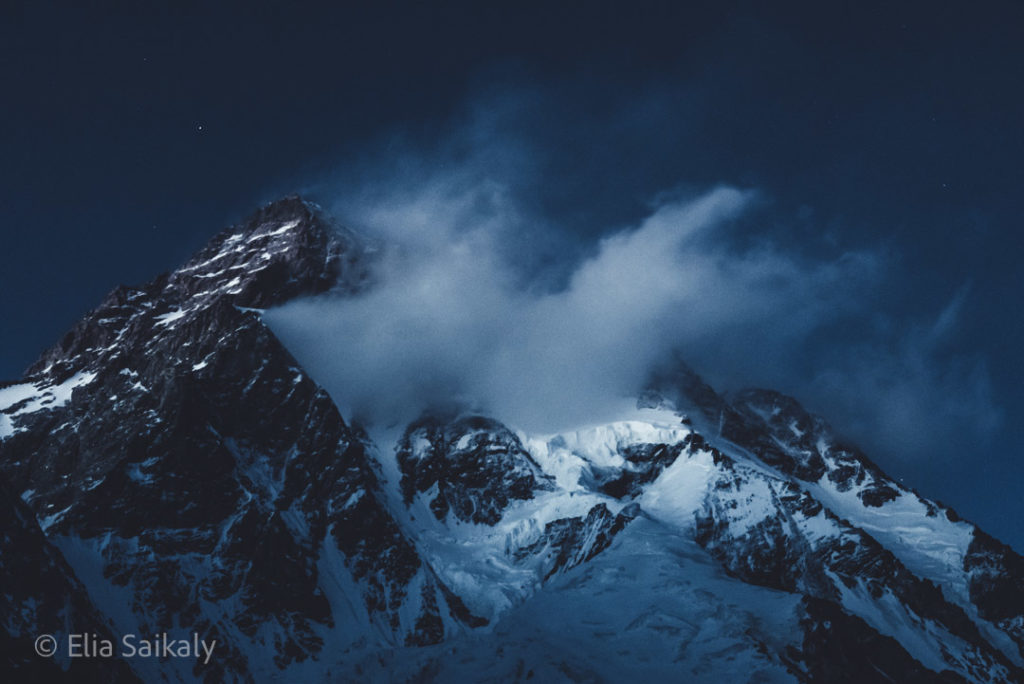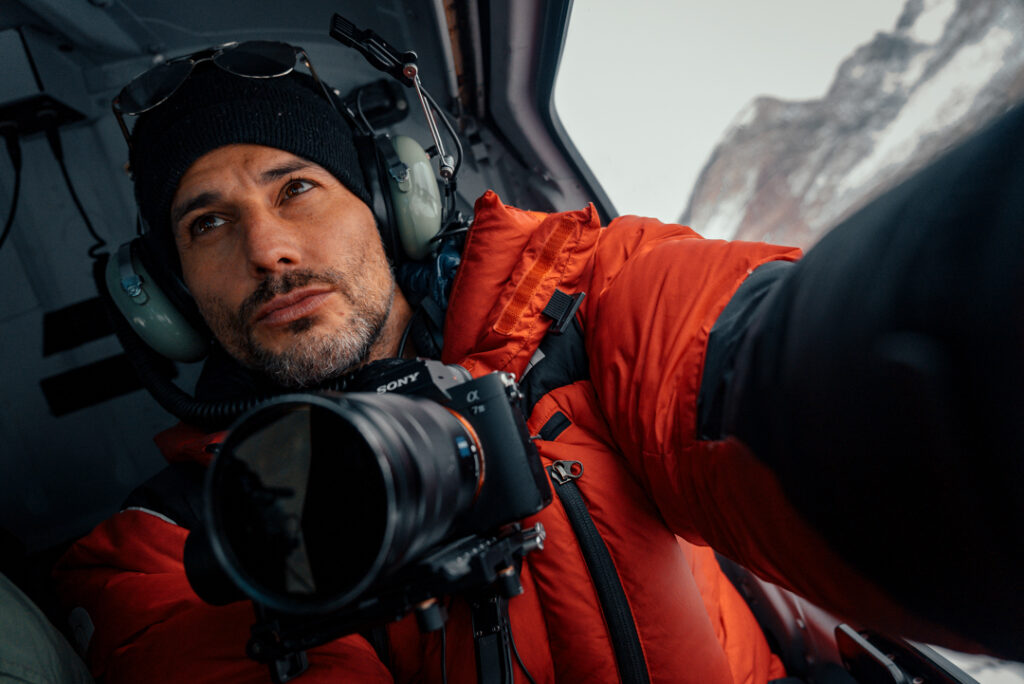Winter 2021: A Historic and Tragic Season
In 2021, I stood on the summit of K2 – the savage mountain. The nickname comes from American climber George Bell, who after a failed 1953 attempt famously said, “It’s a savage mountain that tries to kill you.” K2 is one of the most dangerous and unforgiving peaks on Earth. At the time, fewer people had stood there than had been to space.

It should have been one of the proudest moments of my life. I even became the first Arab to achieve this feat. Instead of pride, I hung my head in shame and never even announced it.
That summit wasn’t a celebration.
It was a reckoning.
What brought me there wasn’t glory.
It was loss. Betrayal. A relentless pursuit of truth. And something I couldn’t yet name.
K2 didn’t just test me. It became a mirror. Forcing me to confront everything I’d spent a lifetime trying to outrun.

In 2021, K2 (8,611m) remained the only 8,000-meter peak never summited in winter despite decades of attempts by some of the world’s most elite climbers. Its reputation had become near-mythical: the final frontier in the harshest season. The last great prize of high-altitude mountaineering.
That winter, I joined an expedition with Ali Sadpara, John Snorri, and Sajid Sadpara.
After years of failed attempts, a team of Nepali climbers finally achieved the impossible: they became the first in history to reach the summit of K2 in winter – using supplemental oxygen. Rather than becoming a source of national pride, their success was marred by controversy and overshadowed by devastating loss.
Ali Sadpara, John Snorri, and Juan Pablo Mohr disappeared during their summit push. They never made it back. Sajid Sadpara, Ali’s son, was the sole survivor.
I had turned back at lower Camp 3 with my film crew, a conservative decision that likely saved our lives. We had assessed the risks and realized we didn’t have enough supplemental oxygen. Not just to survive, but to film John and Ali’s story – our primary objective.

A Gamble for Honor: The Summer 2021 K2 Expedition
When the summer climbing season arrived, I planned to return to complete my work and assist in the recovery mission, backed by a UK production company, a Netflix-trusted vendor. It was the only way I could afford to go back.
But at the last moment, they pulled out. “Too dangerous,” they said.
I was left with a decision:
Walk away.
Or risk everything to return.
With only two weeks’ notice, I made the call.
I cashed in every chip I had, borrowed money at sky-high interest, and assembled a bare-bones expedition with my climbing partner Pasang Kaji Sherpa.
No safety net. No guarantees.
Just one purpose:
To support Sajid in finding his father at a time when not a single person or entity in Pakistan or Nepal was willing to stand by him. To represent the families of the deceased. And to help bring truth and closure to a painful chapter in mountaineering history.

A Summit Marked by Loss
Standing on the summit of K2 wasn’t a choice, it was a calculated decision made out of necessity to protect those climbing that day. On that mountain, where frail fixed lines span unforgiving terrain, even retrieving a camera from a fallen climber can trigger catastrophe. The only way to succeed, and survive, was to stay in motion while a parallel plan quietly unfolded beneath the surface.
Because more often than not, the greatest danger on the mountain… isn’t the mountain. It’s the humans, who, knowingly or not, endanger themselves and those around them.
I had put everything on the line – my life, my savings, my well-being. And in the end, after all we risked, we received threats, fueled by distorted versions of what had unfolded and were chased out of Pakistan. We found ourselves under armed protection from police and intelligence services, relying on an unofficial escape plan to get the footage safely out of the country.
As heroic stories emerged, we stayed silent.
We covered up the lies.
Why?
Honour.
And honour, sometimes, comes at a cost. Paradoxically, so does silence.
Rebirth Through the Mountain
Over time, a pattern began to reveal itself:
- My father’s death in 2018
- Eleven lives lost on Everest in 2019
- The high-stakes recovery on K2 in 2021
- Eighteen dead on Everest in 2023
Each time, while I was investigating tragedy as a filmmaker, I was also unconsciously dissecting myself.
I had to study darkness to understand the darkness.
I began to trace the collective shadow.
The cultural shadow.
The lies we tell ourselves – and each other.
The lengths people will go to succeed.
A trail of bodies.
Collateral damage in the name of achievement.
What began as an investigation into tragic events became a reckoning with myself.
I became obsessed with human behaviour. With pathology. The mechanisms of trauma. Trying to decode what I was witnessing in the world… and why it gutted me.
Like Neo in The Matrix, the red pill wasn’t just bitter, it shattered everything.
I saw the deception. The manipulation. The ego dressed up as virtue. And perhaps the hardest part to reconcile were the victims willingly participating in the manipulation for personal gain and climbers who continue to turn a blind eye so they can carry on with their careers.
Personally, I’d rather torch my ambition and die by the sword than sell my soul.
And then I saw my own reflection. In my shadow.
I wasn’t above it. I was in it.
Drowning in a story I helped write.
My life was in ruins.
I had sacrificed everything for a “mission.”
Burned relationships.
Burned my health.
Burned my sanity.
It became a willing descent into the pits of my own hell. I began piecing it all together: my life, my father’s life, the generational wounds and the architecture of my own attachment. In confronting my shadow, I saw the shadow of these mountains, the unconscious wounds of those who flock to them, and the invisible blueprint running beneath it all.
I began to understand the roots beneath the rebellion. The silence beneath the suffering. And the stories I inherited but never fully understood.
The Journey Back to My Roots
My father was born in Kfarmishki, a small village in the Bekaa Valley of Lebanon.
Like many before him, he left at 20, chasing a better life in Canada. His ascent was different, but just as steep.

I was raised in a Lebanese family, steeped in tradition, but I was also an outsider.
An Arab child in Canada.
Raised in a Jehovah’s Witness household.
Always in between. Never quite home.
That fracture of fundamentalism became the fuel for my fire. It led to rebellion. And eventually, it led to the mountains.
In 2008, my father and I traveled back to Lebanon together. It was a journey of reconciliation, a chance to see him clearly, to understand our family’s story, and to begin healing the wounds of the past.
That same year, I became a registered citizen of Lebanon. A symbolic return to a part of me I had long denied.

In my father’s footsteps
I lost my father in 2018 to a brutal car accident. And the investigator in me couldn’t let it rest. Despite having done the unimaginable at the time, investigating to uncover the events that led to his passing, carrying the weight of being the strongest man at the funeral, standing tall in the face of grief while confronting religious fundamentalism – I still needed to reconcile the truth:
That I couldn’t save him.
As he had saved me.
Over and over again.
Most don’t know about my relationship with the camera. It’s no coincidence I fell in love with it. The camera was passed down to me by my father when I was still a boy.
I followed in his footsteps and eventually took it further than he ever could.


My father and I were both outsiders.
Black sheep.
Each defiant in our own way.
And in time, as I matured, I chose to become the transitional character. The one who doesn’t run from the wound, but turns toward it. The one who breaks the cycle. Who alchemizes pain into healing.
The barrage of pain that came with piecing together the story of K2, especially supporting Sajid in burying his father, was also, unconsciously, my own attempt to bury mine.
For me, this thread of my life and career, was about connecting with my roots, honouring my heritage, and showing others that the mountains hold something far greater than a summit—they hold the power to transform, to heal, and to reveal who we truly are.

The Descent and the Return
A part of me died on K2. Not just because of the friends I lost.But because I watched a sacred pursuit unravel into spectacle. The mountains, once holy, now repurposed for ego and exploitation.
The essence of mountaineering, honour, ethics and camaraderie is disappearing. And in the race to summit K2 in winter, the cost of winning became immeasurable.
The work I did to consciously travel into the depths nearly killed me. And on top of that, I was bamboozled by people I trusted. Exploited, manipulated and taken advantage of. They wanted the fire but cared little for the burn. I was forced to play the game so the world could know this story, the whodunnit, a ‘story’ that nearly cost me everything. I came closer to the edge of madness than I’ve ever been, often contemplating how to quietly escape this existence.
And yet, I survived. And I rode those dragons out like Hercules and Pegasus. Out of the womb of pain – reborn. I returned with an elixir I hope to share, in fragments, to help others find their way back too.
The reckoning became a beautiful journey home to myself. A journey we all, in some form, must take.
The hardest summits aren’t climbed with ropes and ice axes.
They’re the ones that force us to confront who we really are.
And maybe, just maybe,
the greatest summit is finally understanding
why we ever had to climb at all.





